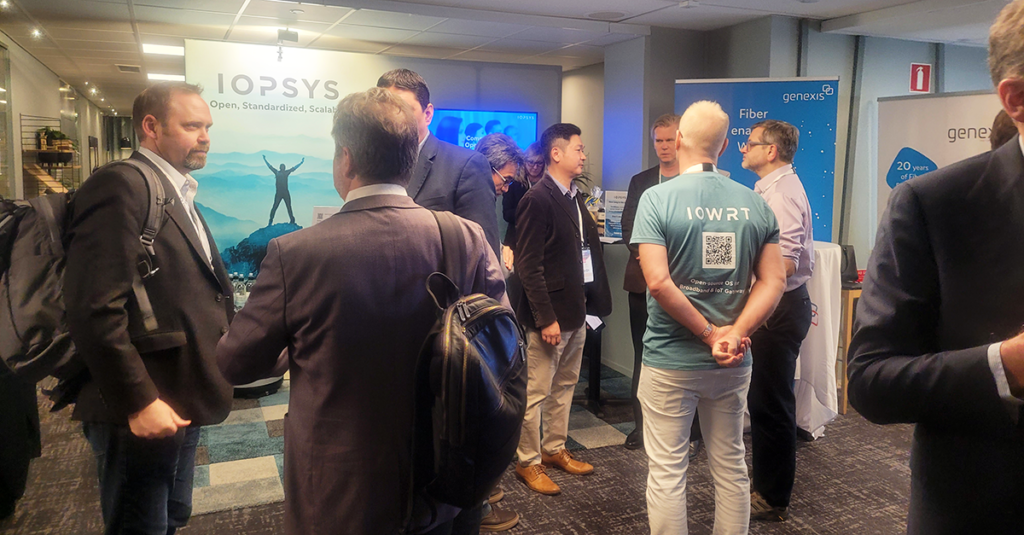
4 Key Takeaways: Wi-Fi for the smart home
by Kajsa Arvidsson

Kajsa Arvidsson, CCO, IOPSYS
The recent Wi-Fi World Congress event in Stockholm was buzzing. It was exciting to see exhibitors, peers and partners in a post-pandemic live event. Informal chats, sharing meals and actually being on stage again fueled many inspiring ideas and business connections. Here are some of my key takeaways and insights about what’s in store for Wi-Fi for the smart home.
1. Wi-Fi demand is bedded for growth, innovation and opportunities. It is expected to increase 6-10 times over the next 10 years.
Edgar Figueroa, CEO and President of Wi-Fi Alliance, set the scene by taking stock of Wi-Fi’s current standing and forecasting its footprint in the next few years. Wi-Fi is ubiquitous and Wi-Fi access meets people’s basic needs – such as searching for a job, getting an education and staying connected to family and friends. In addition, access can bridge the digital divide by connecting underserved communities or connect remote areas such as aircraft carriers or astronauts on the International Space Station.
The current momentum drives global market opportunity with 350M devices in 2022, resulting in outdoor and industrial deployments, higher educational advances, enterprise upgrades and new service provider offerings.
“Wi-Fi is more important than ever, optimized for high performance at low cost and delivers the bulk of the world’s data traffic – up to 90%. Wi-Fi 6E is thriving as dependence on Wi-Fi continues to grow, yet our work to harmonize 6GHz access is not done yet. In addition, innovation continues to fuel advanced use cases and vertical opportunities such as IoT.”
2. Transformation of service providers to experience service providers
According to Tuncay Cil from DZS Cloud, service providers should reconsider how they currently provide services. If they are to unleash future opportunities, the key is to modify how things are done by today in order to transition into experienced service providers of tomorrow. The main recommendations included applying today’s best practices to improve customer satisfaction, quality of experience and churn. Controlling operating costs with support calls, truck rolls and repair success will help manage costs. Offering a premium service package or charging extra fees for premium Wi-Fi contributes to higher average revenue per user.
Another critical step is to create demand for premium services by leveraging the adoption of Wi-Fi management. Tapping into home IoT deployment also shows market potential, as 40% of US households in 2021 have IoT devices, with a 10%* growth rate per year. Furthermore, access to faster, more reliable connectivity is a service consumers are willing to pay for, as 33%** of subscribers often upgrade services when buying a new device.
*Source: Parks Associates, Smart Device Ownership Report 2021
**Source: Parks Associates Survey
3. Service Providers move to open-source and hardware -software separation for connected homes segment
What motivated BT to opt for open-source operating software? Charles Foster shared BT’s journey that led them to separate hardware from software, and develop their gateway and extender software called Indigo. With one software for all platforms, your get an overall faster time to market, cost effective development, better total cost of ownership and ability to use third-party apps.
“As a result, we were able to reduce the development cycle time for services from 9 months to 2 weeks,” said Charles.
BT benefits from many advantages by using IOPSYS’ IOWRT open-source operating system, which is built on functionalities of OpenWrt*** software. Highlighting “the power of many” and how collaboration with a strong open source community such as OpenWRT gives them high quality code where thousands of manhours has been spent on securing the codes high quality and security, in a very short time.
Download your guide to understanding the benefits of an open-source operating system here
***OpenWrt is a trademark owned by software in the Public Interest, Inc.
4. Managed Wi-Fi, QoS, and IoT: future opportunities for Wi-Fi powered smart home
Consumer behaviors and needs presented by Shane Paolo from Plume Design can help service providers tap into new Wi-Fi services and products. “Consumer’s new priorities at home are comfort, convenience and security,” says Shane Paolo.
And many of the presentations touched upon some common themes about market potential and meeting consumer needs. Among them, managed Wi-Fi in the home is a service we might see soon. A smart home is about interactivity with multiple devices and vendors and interacting with it, personalizing and automating it. Connectivity is the underlying need, but it must be a seamless home experience.
Besides performance, more focus on the quality of service is a crucial driver to transition to an experienced service provider. IoT is also a core topic that was mentioned throughout the day, particularly with the increasing number of devices in the home which Wi-Fi 6/6E can support.
The interoperability of applications is already on its way. The adoption of new applications such as Wi-Fi sensing and motion dedication is another application we will see more of. Converting connectivity into services remains a challenge for ISPs. All in all, the future of Wi-Fi is bright!

